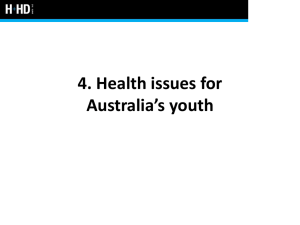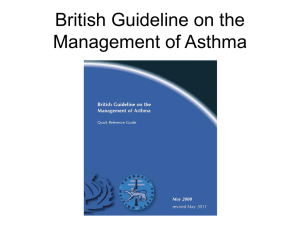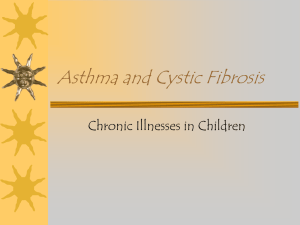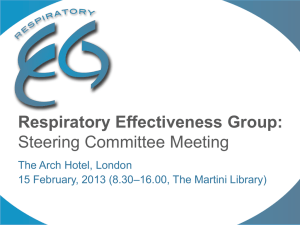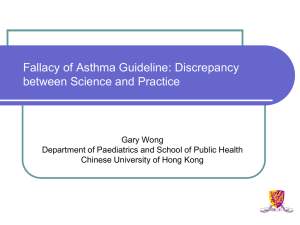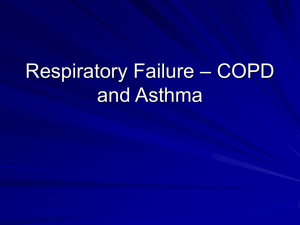COPD
advertisement
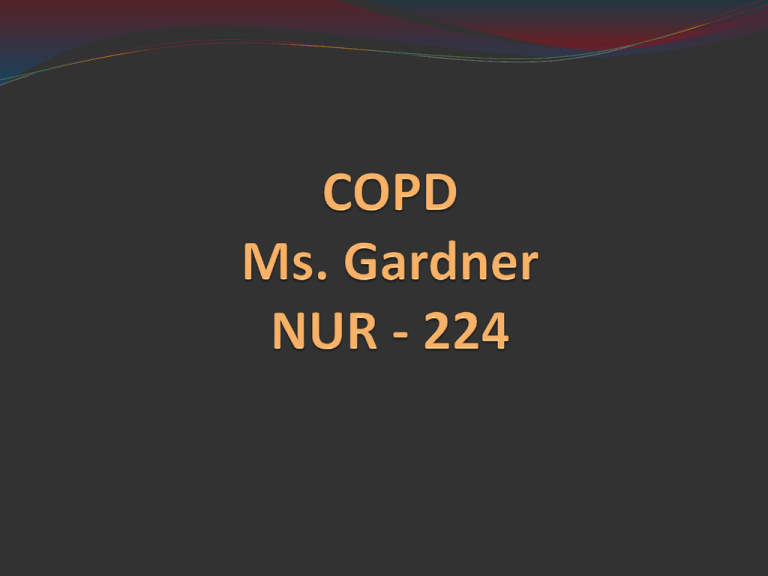
COPD Chronic Obstructive Pulmonary Disease a slowly progressive obstruction of the airways currently is 4th leading cause of death the 12th leading cause of disability. includes diseases that cause airflow obstruction (emphysema, chronic bronchitis) or a combination of these disorders. Asthma is now considered a separate disorder but can coexist with COPD. COPD -Pathophysiology Airflow limitation is progressive and is associated with abnormal inflammatory response of the lungs to noxious agents. This process causes airways to narrow resistance to airflow increases and expiration becomes difficult or slow. The result is a mismatch between alveolar ventilation and blood flow or perfusion impaired gas exchange. Noxious Particles, gases SMOKING! Obstruction (COPD) Inflammation, Scarring of parenchyma & Lumen 4 COPD versus Asthma •Asthma is now considered a separate reversible disorder • No longer under the diagnosis of COPD • Uncontrolled asthma over a lifetime may result in COPD • COPD is not reversible 5 CHRONIC BRONCHITIS A disorder of excess bronchial mucus secretion Productive cough Cigarette smoking Inhaled irritants Mucous-secreting glands and goblet cells increase in number. Ciliary function is reduced, bronchial walls thicken, bronchial airways narrow, and mucous may plug airways. PATHO – CHRONIC BRONCHITIS EMPHYSEMA Impaired oxygen/carbon dioxide exchange Decreased alveolar surface area Hypoxemia result. EMPHYSEMA Alveoli walls continue to breakdown, pulmonary capillary bed is reduced resistance to pulmonary blood flow is increased forcing the ( R) ventricle to maintain a higher pressure in the pulmonary artery. Increased pulmonary artery pressure may cause right-sided heart failure (cor pulmonale). TYPICAL POSTUREEMPHYSEMA RISK FACTORS More common in Whites than Blacks Affect men more frequently than women Affects middle-aged and older adults Tobacco smoke causes 80-90% of COPD cases! Occupational exposure Genetic abnormalities Alpha1-antitrypsin deficiency Cigarette Smoking affect’s the respiratory tract ciliary cleansing mechanism airflow is obstructed irritation of the goblet cells/mucous glands increase mucous production CLINICAL MANIFESTATIONS 3 primary symptoms chronic cough sputum production dyspnea Weight loss Barrel chest Pursed lip breathing CHARACTERISTICS CHEST WALL ASSESSMENT/DIAGNOSTIC FINDINGS Health history Pulmonary function test Spirometry ABG- PCO2 >45 / PaO2 60-80 Screening – alpha 1 – antitrypsin deficiency CBC – RBC/Hct. Key factor dx. – patient’s history/responsiveness to bronchodilators COLLABORATIVE COMPLICATIONS Respiratory insufficiency Pneumonia Chronic atelectasis Pulmonary arterial hypertension (cor pulmonale) MEDICAL MANAGEMENT Risk reduction – smoking cessation / most cost - effective intervention nicotine replacement – gum, inhaler, nicotine patch, positive reinforcement/patient teaching immunization against pneumococcal pneumonia/influenza vaccine reduce the risk of respiratory infection Pharmacologic Therapy MEDICAL MANAGEMENT Bronchodilators Delivered – meter-dose inhalers dry powder inhalers spacer holding chambers nebulizers DRUG THERAPY Bronchodilators Beta2-Adrenergic agonists Proventil (albuterol) Alupent (metaproterenol) Brethine (terbutaline) Anticholinergics Atrovent (ipratropium bromide) • Methylxanthines Aminophylline (Phyllocontin) Theophylline (Slo-bid; Theo-Dur) DRUG THERAPY Corticosteriods • May improve the symptoms of COPD do not slow the decline of lung function • Short term therapy may improve pulmonary function and exercise tolerance . • Long term therapy not recommended Other medications • antibiotics, mucolytic agents, antitussive agents, OXYGEN THERAPY Long term continuous therapy, during exercise, prevent acute dyspnea, during exacerbation Goal to improve mental functioning and quality of life and reduce the work load of breathing O2 sat -90% Low flow devices most common COMPLICATIONS of O2 THERAPY to much O2 CO2 retention COPD OTHER TREATMENTs Surgical Management Bullectomy Lung Volume Reduction Surgery (LVRS) Transplant PATIENT EDUCATION Breathing exercises Activity pacing Oxygen therapy Nutrition therapy Coping measures COpd Nursing diagnoses Ineffective airway clearance Impaired gas exchange Imbalanced nutrition Risk for infection Home/ Community Knowledge of s/s of infection Increase exercise tolerance and prevent further loss of pulmonary function Avoid extremes of heat and cold Avoid stress/emotional disturbances Demonstrate how to use MDI prior to discharge Smoking cessation Utilize resources – home care, support groups, organizations -> American Lung Association ASTHMA Chronic inflammatory disease of the airways episodes of wheezing, breathlessness, chest tightness, and coughing. Most episodes of asthma ”attacks” are brief Acute episodes usually reverse either spontaneously or with treatment ASTHMA Affects more than 22 million people Accounts for more than 497, 000 hospitalizations annually Common chronic disease of children – occurs at any age More common in women than men Patients may experience symptom – free periods alternating with acute exacerbations last from minutes to hours, to days. ASTHMA Pathophysiology airways are in a persistent state of inflammation during this period, neutrophils, and lymphocytes play a role in the inflammation of asthma. when activated they produce chemicals that enhance the inflammatory response increase blood flow, vasoconstriction inflammation progresses airway edema, bronchoconstriction and mucous secretion - narrows the airway ASTHMA CONT’D resistance increases, limiting airflow and increasing the work of breathing. trapped air mixes with inspired air in the alveoli affecting gas exchange hypoxemia hypoxemia hyperventilation decrease in PaCO2 respiratory alkalosis ASTHMA Predisposing factors/Triggers: o exposure to allergens o inhaled irritants o respiratory tract infection o stress, medications, exercise ASTHMA Clinical manifestations Chest tightness, non-productive cough, dyspnea, wheezing Often occurs at night or early in morning Onset Attack may subside rapidly or persist for hours/days During an attack ASTHMA Assessment/Diagnostic findings Episodic symptoms of airflow obstruction Positive family history Pulmonary function test ABGs ASTHMA Preventive Measures Avoiding allergens/environmental triggers Modifying home environment Early treatment of respiratory tract infection ASTHMA Medical Management /Medications therapy Quick relief medications Long acting medications ASTHMA Quick relief medications Beta2- agonists albuterol (Proventil) /levalbuterol (Xopenex) Administered by MDI/DPI Act within minutes Tachycardia, nervousness and muscle tremors Monitor v/s prior to, during, and after treatment ASTHMA Anticholinergic medications Prevent bronchoconstriction Ipratropium bromide (Atrovent), Tiotropium bromide (Spriva) Administered by MDI/inhaler Act more slowly than adrenergic stimulants ASTHMA Systemic Corticosteroids Solu-Medrol, Prednisone very potent and effective anti-inflammatory alleviate symptoms, improve airway function initially used – inhaled form side effect thrush side effects ASTHMA Long-term medications Methylxanthines -Theophylline Relaxes bronchial smooth muscle Monitor serum theophylline levels (10-20ug/mL) Mast Cell Stablizers Cromolyn sodium(Intal), nedrocromil(Tilade) Decreases inflammation, prevents bronchospasm effects Monitor for coughing, skin rash, unpleasant taste ASTHMA Leukotriene Modifiers Montelukast (Singulair), zafirlukast (Accolate) Oral medications – reduces the inflammatory response in asthma, improves lung function Affects the metabolism and secretion of other medication – warfarin, theophylline May cause liver toxicity Administer with meals ASTHMA Management of Exacerbations Early treatment and education Quick – acting beta 2 adrenergic agonist Systemic corticosteroids’ Oxygen supplementation Antibiotics Peak Flow Monitoring ASTHMA Peak expiratory flow monitoring measures the highest airflow during a forced expiration establishes the patient’s personal best or normal PERF value is used to evaluate the severity of airway obstruction Traffic signals are used for simplicity – green (80 to 100%) yellow 50-80% red 50 % or less ASTHMA Nursing management – depends on severity of symptoms Acute asthma attacks cause – fear as breathing becomes more difficult hypoxemia Priority during an attack – improve airway clearance and reduce fear and anxiety Teach about prevention of future attacks and home management ASTHMA Ineffective airway clearance Anxiety Community based - care STATUS ASTHMATICUS Severe /persistent asthma that does not respond to routine treatment Without aggressive therapy respiratory failure Attacks can occur with little or no warning can progress rapidly to asphyxiation


